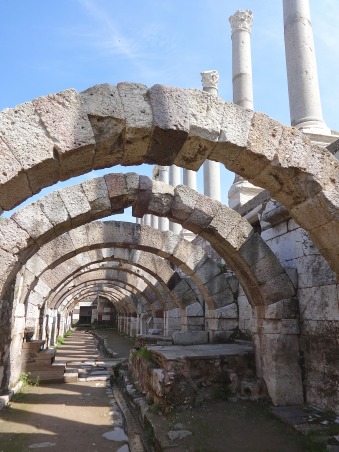Open daily 8.30am-7pm (8.30am-5.30pm winter). Admission: TL210
Right in the centre of İzmir, just off Anafartalar Caddesi in Basmane and within easy walking distance of the bazaar, are the extensive remains of the Agora, the Graeco-Roman marketplace which would once have been surrounded on three sides by porticoed stoas and closed off on the fourth by a basilica that served as the law courts.
Today some of the pillars on one side of the Agora have been re-erected. More interestingly they stand above extensive underground galleries designed to convey water around the city. Some parts can be explored; infuriatingly, the parts where there are said to be interesting graffiti cannot. These galleries may also have served as an underground bazaar area.
The Agora is thought to date back to the 4th century BC although it took its final form in the 2nd or 3rd century AD. It survived as the main market place until the 7th century. Access from the harbour area (beneath what is now the Kemeraltı bazaar area) on the west side would have been via the Gate of Faustina or via the North Avenue (what is now Anafartalar Caddesi). The Gate of Faustina is believed to have carried a portrait of Faustina, the wife of Marcus Aurelius, who had done much to help rebuild the city after a serious earthquake in 178 AD. 
Much of the central area is covered with pillars and other pieces of masonry that many one day be pieced together again to give a better idea of how things would have looked. At the back of the Agora a collection of gravestones survive from the days when an Ottoman graveyard stood above the ruins.
If you look upwards at the back of the site you will be able to see the remains of Kadifekale (Velvet Castle) looking down on the site. Off to one side the shattered remains of the house of Sabetay Sev are being restored to serve as a museum house which may or may not be a good thing.

